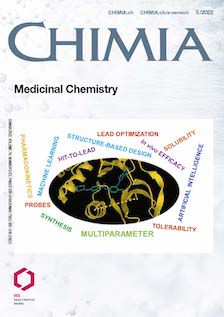The Bitter Taste Receptor TAS2R14 as a Drug Target
DOI:
https://doi.org/10.2533/chimia.2022.418PMID:
38069713Keywords:
Bitter taste receptor, Drug discovery, Flufenamic acid, GPCRsAbstract
G protein-coupled receptors (GPCRs) mediate most of our physiological responses to hormones, neurotransmitters and environmental stimulants. Besides human senses like vision and olfaction, taste perception is mostly mediated by GPCRs. Hence, the bitter taste receptor family TAS2R comprises 25 distinct receptors and plays a key role in food acceptance and drug compliance. The TAS2R14 subtype is the most broadly tuned bitter taste receptor, recognizing a range of chemically highly diverse agonists. Besides other tissues, it is expressed in human airway smooth muscle and may represent a novel drug target for airway diseases. Several natural products as well as marketed drugs including flufenamic acid have been identified to activate TAS2R14, but higher potency ligands are needed to investigate the ligand-controlled physiological function and to facilitate the targeted modulate for potential future clinical applications. A combination of structure-based molecular modeling with chemical synthesis and in vitro profiling recently resulted in new flufenamic acid agonists with improved TAS2R14 potency and provided a validated and refined structural model of ligand–TAS2R14 interactions, which can be applied for future drug design projects.
Downloads
Published
Issue
Section
License
Copyright (c) 2022 Lukas A. W. Waterloo, Stefan Löber, Peter Gmeiner

This work is licensed under a Creative Commons Attribution 4.0 International License.







